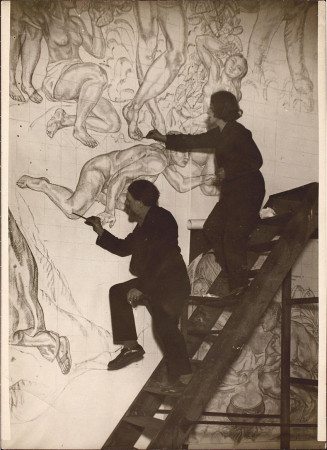André and Ivanna Lemaître

Legende
André-Hubert Lemaitre and his wife, Ivanna Lemaitre. Paris, circa 1925.
Credit
© Albert Harlingue / Roger-Viollet
Ivanna Jacovlena Koytcheff was born in Saint-Petersburg in 1893. At an unknown date, she arrived in France and married André-Hubert Lemaître (Paris, 1885-1965), a painter who trained at the École Nationale des Arts Décoratifs then at the École Nationale des Beaux-Arts. They had two sons, Jérôme (Paris, 1917 - Nice, 2002) and Jean (Paris, 1921 - Nice, 2007).
Through the many monumental decors that they created together in churches, schools and at the Palais de la Porte Dorée, the Lemaîtres distinguished themselves brilliantly in their reinvention of monumental decor during the inter-war period, particularly with regard to fresco creation. The two artists also had bodies of work in their own right, which continued after World War 2. While their decors attracted the attention of a few critics when they were alive, they have been somewhat forgotten since.
Joint creations
From the 1920s, André and Ivanna Lemaître devoted themselves to the monumental decoration of religious buildings (frescoes or mounted paintings). Their career started in Toulouse, where they decorated two chapels: at the Notre-Dame de la Charité convent (1924) and at the Institut Catholique (la Trinité). It continued in the Paris region with, in 1929, decoration of the triumphal arch at the Église Sainte Jeanne d’Arc in Meudon (the paintings have now disappeared). In 1932-1934, they painted a large fresco for the Chapelle du Travail in the Église du Saint-Esprit (Avenue Daumesnil, Paris 12th arrondissement): l’Eglise par ses papes, ses clercs et ses laïcs, which combines Sainte-Bernadette in Lourdes, Pope Pius IX proclaiming the dogma of the Immaculate Conception, the first Vatican council, and the curate of Ars. And in 1945, they created the fresco for the triumphal arch at the Église Sainte-Hélène (Rue du Ruisseau, Paris 18th arrondissement), on the life of the saint and her son, Emperor Constantine.
In 1931, they received their first civil order: the frescoes in the Salon Lyautey (or Salon Asia) at the Palais de la Porte Dorée, on the theme of the artistic and spiritual contributions made by Asia. The colours are soft, dominated by yellows and ochres, and the illustrations sinuous, echoing Eugène Printz’s furniture. To the left of the entrance, three spiritual masters preside (Buddha, Confucius, Krishna), and to the right, a caravan of elephants makes its way carrying riches from Asia; the other walls cover the themes of the arts (dance, music, sculpture) and Vedic legends (prior to Hinduism) with the four elements. A set of preparatory drawings for this project is kept at the Musée du Quai Branly - Jacques-Chirac.
In 1933, the Lemaîtres received an order from the City of Paris: six large fresco panels for the preschool on Boulevard Davout; they feature a scene with the puppet Guignol, landscapes, children’s games (the decor is now gone, only the sketches have been kept). In 1935, the two artists received another order from the State (although the order was in Ivanna’s name, it was doubtless carried out by the two of them): two large paintings destined for the conference room at the École Nationale des Arts et Métiers: Le don du feu aux hommes and Paris (travaux publics); they were installed at the end of 1937. The two compositions, with their powerful style, in a colour range dominated by blue, are directly in line with the decor of the Asia Salon at the Palais de la Porte Dorée.

Credit
Photo : Lorenzo © Palais de la Porte Dorée
Ivanna Lemaître’s personal body of work
The artist also produced paintings (landscapes of the Midi or Spain, portraits), which she exhibited regularly at the Salon d’Automne. An excellent illustrator with a lively style, she illustrated books (engraved wood for André Chénier’s Idylles et élégies in 1926) and exhibited her drawings in galleries.
After the war, Ivanna left to settle in Nice for health reasons. She then began a second career, partly dedicated to monumental decor using mosaic: in Nice, the triumphal arch at the Église du Sacré-Cœur with her son Jean (1961), the lobby of a Caisse d’Épargne, the entrances to luxury buildings (Le Michelet, L’Age d’or, Alsace-Lorraine), a high school, and in Cagnes-sur-Mer, the wall of an apartment building; all in an abstract style that she also adopted for her isolated works. Her last decor was a glass paste wall for the preschool belonging to the Jules Vedrines school system in Drancy, completed after her death by her son (through the French state’s 1% artistique programme). She died in Nice in 1973 and is buried in the Russian cemetery in Caucade.
André Lemaître’s personal body of work
In 1941, André Lemaître painted a fresco on the triumphal arch at the Église Saint-Gabriel in Paris, on which can be seen, from bottom to top: the prophets Daniel and Isaiah, the prophecies announced by the four evangelists, and Christ surrounded by angels. He was also the creator of landscapes and still-life paintings that he exhibited regularly at the Salon d’Automne and the Salon des Tuileries. Several of his works feature in French public collections (MNAM, City of Paris).



